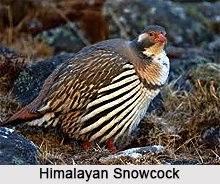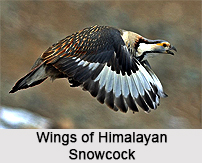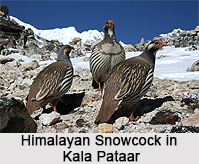
Himalayan snowcock with a scientific name Tetraogallus himalayensis is a snowcock in the pheasant family Phasianidae found across the Himalayan ranges and parts of the adjoining Pamir range of Asia.
Concentration of Himalayan Snowcock
Himalayan snowcock is found on alpine pastures and on steep rocky cliffs where they will dive down the hill slopes to escape. It overlaps with the slightly smaller Tibetan snowcock in parts of its wide range. The populations from different areas show variations in the colouration and about five subspecies have been designated. They were introduced in the mountains of Nevada in the United States in the 1960s and a wild population has established in the Ruby Mountains.
Structure of Himalayan Snowcock
Himalayan Snow-Cock is a large grey partridge-like bird, 55-74 cm in length and weighing 2-3.1 kg. The head pattern has a resemblance to that of the smaller and well marked chukar partridge. The white throat and sides of the head are bordered by chestnut moustachial stripe and a dark broad chestnut band stretching from the eye over the ear, expanding into the collar. The upper parts are grey, with feathers of the rump and the wings are bordered with rufous. The upper breast is grey with dark crescent bars. The lower breast plumage is dark grey, and the sides of the body are streaked with black, chestnut and white. The under tail coverts are white. The legs and orbital skin are yellow. Sexes are alike in plumage, but the female is smaller and lacks the large tarsal spur of the male. In flight, from above, the white primaries tipped in black and the rufous outer tail feathers make it distinctive.  The Tibetan snowcock has a wing pattern with white trailing edge to the secondaries that contrasts with the grey wings
The Tibetan snowcock has a wing pattern with white trailing edge to the secondaries that contrasts with the grey wings
History of Himalayan Snowcock
Around 1841 specimen of a bird was brought to the menagerie of the Zoological Society of London, presented by E W Bonham, consul at Tabrez. A molecular phylogenetics study suggests that the Tibetan snowcock represents an early or older divergence from the common ancestor of the snowcocks. The main populations are separated by the Taklamakan desert and the separation has been estimated to have happened after the Pleistocene glaciations. The large distribution range is fragmented and these disjunct populations show variations in plumage that have been named as subspecies. Although several subspecies have been described, not all are recognized. The nominate subspecies was described by G. R. Gray in 1843 and refers to the populations from eastern Afghanistan extending to Ladakh and the central Himalayas of Nepal. In 1961 the similarity of the Himalayan landscape to the Nevada region was noted and the Himalayan snowcock was considered as a good game bird for introduction by the Nevada Fish and Game Commission. The Commission then approached the President of Pakistan for some birds. These were wild trapped in Hunza and early shipments faced heavy losses after which birds were locally reared at Mason Valley game farm and for over a 15-year period (1965-1979) more than 2000 birds were released into the wild. A wild population more than 200 to 500 birds has established itself in the Ruby Mountains, where they forage above the treeline.
Habitats of Himalayan Snowcock
 Himalayan Snowcocks are gregarious when not breeding, moving around in small groups. Several groups may inhabit the same hill. They keep entirely opening country and seeming to prefer rocky hill-sides. They feed on grass, shoots, berries and seeds. In the mornings the birds fly downhill to drink water. When approached from below their level, they attempt to climb up the slopes on foot and when approached from above they dive down the valleys on open wings. In India, the breeding season is in summer, April to June. It is silent in winter but in spring, its call is a familiar part of the landscape. The song is a loud whistle with three parts with the tone ascending. They also make a rising, shrill piping call.
Himalayan Snowcocks are gregarious when not breeding, moving around in small groups. Several groups may inhabit the same hill. They keep entirely opening country and seeming to prefer rocky hill-sides. They feed on grass, shoots, berries and seeds. In the mornings the birds fly downhill to drink water. When approached from below their level, they attempt to climb up the slopes on foot and when approached from above they dive down the valleys on open wings. In India, the breeding season is in summer, April to June. It is silent in winter but in spring, its call is a familiar part of the landscape. The song is a loud whistle with three parts with the tone ascending. They also make a rising, shrill piping call.
Breeding Season of Himalayan Snowcock
The breeding season is summer, April to June. During courtship, the male crouches low down to the ground with wings slightly spread, tail depressed and feathers slightly ruffled. Then, he runs backward and forward in front of the hen or in circles. The nest is a bare ground scrape sheltered under a stone or bush, preferably close to the crest of a ridge on the leeward side. About 5 to 12 long oval eggs are laid which are a stony olive or brown colour and spotted throughout with red or brown. The eggs are incubated only by the female. The male is monogamous, staying in the vicinity of the nest often seen perched on some elevated rock and keeping a watch against intruders. When disturbed, the cock warns the female with a loud whistle. If caught unaware in the nest, the hen bird will not leave the nest until approached very close. The eggs hatched in an incubator after about 27-28 days.











